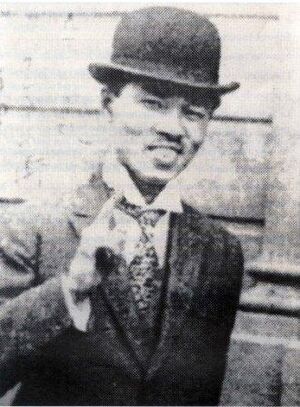George Ohsawa facts for kids
George Ohsawa (born Nyoichi Sakurazawa; October 18, 1893 – April 23, 1966) was a Japanese writer and a supporter of alternative medicine. He is famous for starting the macrobiotic diet. When he lived in Europe, he used different pen names like Musagendo Sakurazawa and Nyoiti Sakurazawa. He wrote about 300 books in Japanese and 20 in French. Ohsawa believed that good health meant having no tiredness, a good appetite, good sleep, a good memory, a good mood, clear thinking, and being thankful.
Life of George Ohsawa
Ohsawa was born into a poor samurai family in Shingu City, Japan. He did not have enough money to go to college. Around 1913, he joined the Shokuiku movement, which focused on healthy eating. He learned from Manabu Nishibata, a student of Sagen Ishizuka, in Tokyo.
Ohsawa claimed he cured himself of tuberculosis when he was 19. He did this by using old Chinese ideas like yin and yang. He also followed the teachings of Sagen Ishizuka, who believed in curing illnesses with traditional food.
Later, Ohsawa traveled in Europe and began sharing his ideas in Paris. During this time, he chose his pen name "Ohsawa." It is said to come from the French phrase Oh, ça va, which means "All right" or "I'm doing fine." After several years, he went back to Japan to start a group and teach his ideas. In 1931, he published a book called The Unique Principle, which explained the yin and yang order of the universe.
During World War II, Ohsawa spoke about his pacifist (anti-war) beliefs. He even wrote a book that predicted Japan would lose the war. Because of this, he was put in prison and almost faced death. After being freed by U.S. General MacArthur, he moved his school to a quiet area in the mountains of Yamanashi Prefecture.
In 1961, Ohsawa wrote Zen Macrobiotic. This book talked about the macrobiotic diet, which had been known in Germany since 1796. After this, Ohsawa's ideas became widely known as macrobiotics.
While in France, Ohsawa wrote many books in French. One of them was L'Ere Atomique et la Philosophie d'Extrême-Orient (The Atomic Age and the Philosophy of the Far East). He wrote this during the Cuban Missile Crisis, a time when there was a lot of tension between countries. In his books, Ohsawa explained how macrobiotics could help solve social problems and even prevent wars. He believed that war was a mistake in judgment and could be avoided.
Ohsawa also used a traditional Japanese way of checking health called "sanpaku" (meaning "three whites"). This is when you can see white areas below and on the sides of the iris (the colored part of the eye). It was seen as a sign of being very tired or accident-prone. Samurai warriors used this to judge an enemy's strength. Ohsawa used this idea to talk about a person's general health.
His ideas caught the attention of William Dufty, who found relief from his own health issues by following Ohsawa's brown rice diet. Dufty became a supporter of macrobiotics and met Ohsawa in Paris. Ohsawa gave Dufty his writings and asked him to share them with the world. In 1965, Ohsawa's writings were published under the title You Are All Sanpaku.
Death
George Ohsawa died from a heart attack in 1966. He was 72 years old.
Books by George Ohsawa
Here are some of the books George Ohsawa wrote:
- 1931: Le Principe unique de la philosophie et de la science d’Extrême-Orient, Paris: Vrin.
- 1932: Le Livre des fleurs, Paris: Plon.
- 1952: Le Livre du Judo, Tokyo: Sekai Seihu.
- 1954: The Two Great Indians in Japan, Sri Rash Benhari Bose and Netaji Subhas Chandra Bose, India: Sri K. C. Das.
- 1956: Jack et Madame Mitie en Occident, Paris: E.D.
- 1956: La Philosophie de la médecine d'Extrême-Orient, Paris: Vrin.
- 1961: Zen macrobiotique, Bruxelles: I.D.M..
- 1961: Acupuncture macrobiotique, Paris: Sésame.
Books translated by Ohsawa
- T. Nakayama (1934): Acupuncture et médecine chinoise vérifiées au Japon, Paris : Le Francois.
Japanese works
- Macrobiotics
- History of China From 2000 B.C. Until Today
- Franklin: A physiological and biological biography
- Gandhi: A physiological and biological biography
- Clara Schumann and Her Father: A physiological and biological Study
- Translation and critique: The Encounter Between East and West by F. S. C. Northrup
- Translation and critique: Man the Unknown by Alexis Carrell
- The Fatality of Science
See also
 In Spanish: George Ohsawa para niños
In Spanish: George Ohsawa para niños
- Japanese resistance to the Empire of Japan in World War II


